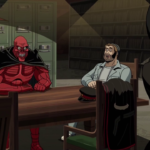
Joe Kelly is no stranger to the world of superheroes. With a resume that includes heavy hitters like the X- Men, The Justice League, Deadpool, and even a run on Amazing Spider-Man, it is not surprising to see Kelly take the reins of the newest Spider-Man ongoing series Non-Stop Spider-Man.
Men, The Justice League, Deadpool, and even a run on Amazing Spider-Man, it is not surprising to see Kelly take the reins of the newest Spider-Man ongoing series Non-Stop Spider-Man.
The solicit for the first issue promises the most action-packed, pulse-pounding, adrenaline-pumping comic OF ALL TIME! Once we get into the actual comic, we find Spider-Man in mid-chase and a little more upset than normal. A flashback reveals what has put Spider-Man in such a sour mood and why this chase feels so personal. By the end of Non-Stop Spider-Man #1, what seemed like a simple take down of some street level criminals is revealed to have connections to a much bigger criminal enterprise, as a classic villain makes his return.
When boiled down, Joe Kelly’s plot is a rather simple one that people can relate to. However, it is his style of writing that really does make the script feel like it is moving at break-neck speed. As Spider-Man moves through the panels, Kelly allows us to see into the hero’s head, which is functioning differently than it normally operates. And while the action is fast and furious, the flashback panels give Kelly a chance to build a backstory at a pace that does not interfere with the present-day setting.
While it is never specifically stated, it can be assumed that Non-Stop Spider-Man is taking place in the current Marvel timeline. With Peter being back in college, it allows Kelly to explore a subject that Peter may not have dealt with otherwise. While I appreciate that Kelly is trying to keep things fresh by tackling current social issues, one of my biggest complaints is the overuse of pop-culture references. In just this first issue alone we get Bridgerton, Spider-Man saying someone’s threads “slap,” and a big bad saying that someone has “drip.” Comics often take from the popular culture around them, but here it feels forced, and I worry that it will make this story feel very dated in just a few months.
Nevertheless, it’s Chris Bachalo’s pencils make this a must read. His style allows the emotions of the characters to jump off the page without sacrificing too much realism. His choice to put all of the panels at an angle gives an extra sense of movement, adding to the speed of the story. In addition, the decision to use more traditional panel designs for the flashbacks makes it easy to separate them from the current storyline. Also, the way the art bleeds from panel to panel plays perfectly into Kelly’s constantly moving script. The color palette is bright and warm throughout, reminding people that this is indeed a Spider-Man story. Even more important, it is obvious throughout that Spidey’s suit is red and blue, not black.
Despite some small pitfalls Non-Stop Spider-Man #1, reads like a comic by a veteran team that knows exactly what they are doing. The end of the issue leaves us with a cliffhanger and introduces us to the first big bad. Fans of Spider-Man will feel as if they have just slipped back into a classic storyline that still manages to be relevant.




